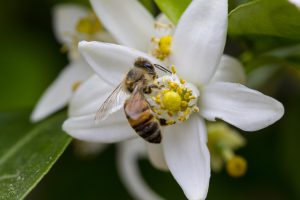Citrus is Florida’s most valuable crop, with over 430,000 acres in citrus groves throughout the state. Florida citrus is harvested October-June. Most of Florida’s citrus is processed for juice, but plenty of fresh fruit is available at groves, farm stands, and groceries throughout Florida.

Various kinds of citrus ripen at different times. Temple and Valencia oranges, tangerines and red grapefruit are available now for eating fresh. Check local produce stands or pick your own citrus; see Deer Park Peaches for select “U-pick” dates.
Citrus provides more than delicious fruit. By summer, beekeepers will be harvesting orange blossom honey, a Florida favorite.
The history of Florida citrus
Citrus was brought to Florida in the 1500’s by Spanish explorers. By the 1800’s, it was being grown widely as a commercial crop. Freezes, hurricanes, and disease have devastated the citrus industry over the decades, but Florida remains the top citrus-producing state in the U.S.
Since the 2000’s, citrus greening disease has been impacting Florida citrus. The disease shortens the life of the trees and decreases fruit quality. With citrus greening, many former citrus groves were converted to development. When agricultural land is developed, it can no longer provide benefits like supplying us food, agritourism or aquifer recharge. Conserving agricultural lands is essential to the health of our environment, our economy, and our food security.
Many scientists and growers have been working to overcome citrus greening. New greening-resistant citrus varieties are now being grown, and improved fertilization programs are being used that keep trees healthier to resist the effects of greening.
Don’t judge a fruit by it’s peel
Understandably, many people think oranges should be orange when they are ready to pick. In fact, many citrus in Florida are still green on the tree when they are fully ripe and ready to eat. Citrus fruits turn color in response to cool temperatures, which sometimes do not occur in Florida. To meet consumer expectations of how citrus is “supposed” to look, many citrus fruits are treated with harmless ethylene gas or even dyed to color their peels. Some Florida citrus may have blemishes on the peel, but this does not affect the quality of the fruit inside.
Grow your own citrus
If you want to grow your own citrus trees, start by selecting a sunny, well-drained site. Soil pH should be 5.5-6.5; call UF IFAS Extension for a soil test kit.

Purchase grafted trees from a nursery. Several greening-resistant citrus are now available to backyard growers, including: ‘Sugar Belle’ and UF 13-51 mandarins, key lime, and Australian finger lime. In Osceola County, find citrus trees at Nick’s Edibles, or order trees online from nurseries like Brite Leaf Citrus Nursery, Backyard Citrus Trees, or Harris Citrus Nursery.
To help citrus trees survive with citrus greening, fertilize frequently with small amounts of fertilizer. For example, apply a granular citrus fertilizer with micronutrients in March, May, July, and September. Citrus need regular soil moisture; water trees to get them established and during dry periods (when the soil is dry under the surface). See this UF factsheet for more tips on growing backyard citrus.
For information and classes on gardening and farming in Osceola County, FL, contact the UF IFAS Extension, 321-697-3000.
 0
0
